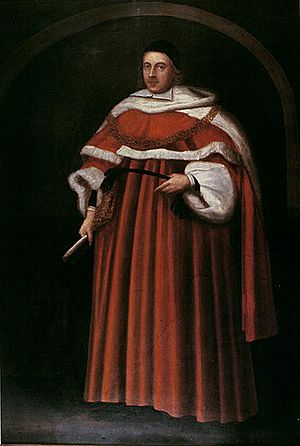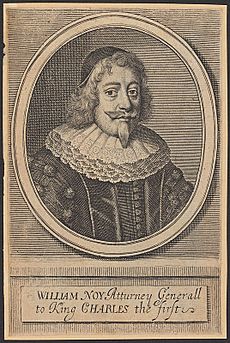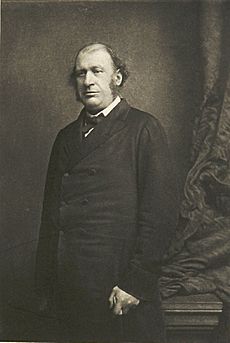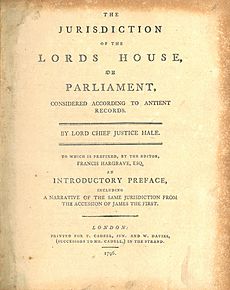Matthew Hale (jurist) facts for kids
Quick facts for kids
Matthew Hale
|
|
|---|---|
 |
|
| Chief Justice of the King's Bench | |
| In office 18 May 1671 – 20 February 1676 |
|
| Preceded by | John Kelynge |
| Succeeded by | Richard Raynsford |
| Chief Baron of the Exchequer | |
| In office 7 November 1660 – 1671 |
|
| Preceded by | Orlando Bridgeman |
| Succeeded by | Edward Turnour |
| Justice of the Common Pleas | |
| In office 31 January 1653 – 15 May 1659 |
|
| Preceded by | John Puleston |
| Succeeded by | John Archer |
| Personal details | |
| Born | 1 November 1609 West End House (now The Grange or Alderley Grange), Alderley, Gloucestershire, England |
| Died | 25 December 1676 (aged 67) The Lower House (see Alderley House) |
| Spouses | Anne Moore Anne Bishop |
| Residence | The Lower House (see Alderley House) |
| Alma mater | Magdalen Hall, Oxford (now Hertford College) |
Sir Matthew Hale (born November 1, 1609 – died December 25, 1676) was an important English lawyer and judge. He is best known for his book, The History of the Pleas of the Crown. This book was about serious crimes against the King.
Matthew Hale's parents died when he was very young. He was raised by a relative who was a strict Puritan. He first planned to become a priest. However, he later decided to become a lawyer, like his father. He joined Lincoln's Inn in 1628 and became a lawyer in 1636.
As a lawyer, Hale represented many important people during the English Civil War. Even though the Royalist side lost, Hale was known for being fair and honest. This helped him avoid trouble. Under the new government, he led a group called the Hale Commission. This group looked into ways to improve the law. Later, Oliver Cromwell made him a judge.
Hale was also a member of Parliament. After the King returned to power, Hale became a very important judge. He was first the Chief Baron of the Exchequer, then the Chief Justice of the King's Bench. He was known for his honesty in both roles. He retired in 1676 due to illness and died later that year.
Hale's books greatly influenced English law. His Historia Placitorum Coronæ is still considered a very important book. His Analysis of the Common Law was the first history of English law. It also influenced other famous legal writers. Some modern experts criticize Hale for his role in witchcraft trials. They also note his views on punishment for young people.
Contents
Matthew Hale's Early Life and Education
Growing Up in England
Matthew Hale was born on November 1, 1609. His home was in Alderley, Gloucestershire, England. His father, Robert Hale, was also a lawyer. Robert Hale stopped practicing law before Matthew was born. He felt that some legal practices were not honest.
Matthew's parents both died before he turned five. His mother died in 1612, and his father in 1614. Matthew was then cared for by a relative, Anthony Kingscot. Kingscot was a strong Puritan. He made sure Matthew was taught by a strict Puritan vicar.
School Days and New Plans
In 1626, at age 16, Matthew went to University of Oxford. He planned to become a priest, as his family wished. He studied hard and was good at fencing. He was also very religious.
However, Matthew started going to plays and social events. His studies suffered, and he drifted away from his Puritan beliefs. He decided not to be a priest. Instead, he wanted to become a soldier. His family tried to change his mind. Matthew said lawyers were "a barbarous set of people."
Becoming a Lawyer
Matthew's plans to be a soldier changed after a legal problem with his family's property. He talked to a lawyer named John Glanville. Glanville convinced Matthew to become a lawyer.
At age 20, Matthew left Oxford without a degree. He joined Lincoln's Inn on November 8, 1628. He promised himself never to see a play again. He returned to his Puritan faith. He studied law for up to 16 hours a day at first. He also studied Roman law, history, and science. He avoided news and social events to focus on his studies.
Hale's Career as a Lawyer and Judge
Working as a Barrister
On May 17, 1636, Matthew Hale became a barrister. He became a close friend and student of William Noy, a famous lawyer. Hale also met John Selden, a very learned man. Selden encouraged Hale to study more than just law.

Hale became a successful lawyer. He let his Christian faith guide his work. He tried to help the court find a fair outcome. He often returned half his fee or charged a low price. He refused to take cases he thought were unfair. He always tried to be on the "right" side.
Despite this, he became quite wealthy. He was in high demand. In 1641, he advised Thomas Wentworth, who was accused of treason. Hale also defended William Laud, the Archbishop of Canterbury, in 1644. Hale argued that Laud's actions were not treason. Parliament eventually found Laud guilty anyway.
Defending King Charles I
After King Charles I was captured, Hale offered to defend him. The King refused to accept the court's authority. It is believed that Hale helped the King prepare this defense.
As the King's side lost the Civil War, Hale helped negotiate the surrender of Oxford. This saved the city's libraries. Hale stayed out of the war's politics. He was known for his honesty. He told people who questioned his defense of Royalists that he was defending the law. He said he was doing his duty to his client.
The Hale Commission for Law Reform
During the time of the Commonwealth, there was a strong desire to change the law. Many judges were corrupt. The criminal law was very harsh. Most serious crimes were punishable by death. Court procedures were in an old form of French. Judges sometimes jailed juries for verdicts they didn't like.
Oliver Cromwell wanted to create a "new society." This included reforming the law. On January 30, 1652, Hale was chosen to lead a group to study law reform. This group became known as the Hale Commission. It looked at how to fix delays and high costs in legal cases.
The Commission suggested many changes. These included reducing the use of the death penalty. They also wanted to allow accused people to have lawyers. The Commission produced 16 bills. None of these became law right away. However, most of their ideas eventually became part of English law.
Becoming a Judge
Oliver Cromwell noticed Hale's skills. He asked Hale to become a judge. Hale worried that this would make people think he supported Cromwell's government. But he was convinced to accept.
On January 31, 1653, Hale became a Justice of the Court of Common Pleas. This was one of the main courts in England. He agreed to be a judge only if he didn't have to recognize Cromwell's authority. He also refused to sentence people to death for crimes against the government. He believed it would be murder to do so.
William Blackstone, another famous lawyer, later wrote about this. He said that if a judge not authorized by law gives a death sentence, it is murder. Hale refused to try prisoners in cases related to the government. He had strong doubts about Cromwell's legal right to appoint judges. Hale retired from this role on May 15, 1659.
Serving in Parliament
On September 3, 1654, Hale was elected to Parliament for Gloucestershire. He was an active member. He helped stop a plan to destroy the Tower of London's old records. He also suggested ways to protect Parliament's power.
Hale proposed that the government should be led by Parliament and a single person. He also suggested that the King's advisors should be re-elected every three years. Cromwell did not allow MPs into Parliament unless they signed an oath recognizing his power. Hale refused to sign. So, his ideas were not passed. Cromwell dissolved Parliament in 1655.
Hale was called to the Upper House of Parliament in 1657. This new house was meant to replace the old House of Lords. But its power was questioned. Cromwell dissolved Parliament again in 1658.
After Oliver Cromwell died, his son Richard Cromwell became leader. A new Parliament was called in 1659. Hale was elected as an MP for Oxford University. Richard Cromwell was a weak leader. He resigned after eight months.
In 1660, General Monck forced Parliament to call new elections. Charles II made a promise called the Declaration of Breda. When the new Parliament met, Hale suggested they discuss bringing Charles II back as King. On May 1, Parliament restored the King. Charles II returned to England three weeks later. This event is known as the English Restoration.
Hale's Role in the English Restoration
Chief Baron and Chief Justice
Hale's first job in the new government was to be part of a group of 37 judges. They tried 29 people who had signed the death warrant for Charles I. All were found guilty of treason. Ten were executed. Some people thought Hale was being unfair, as he had worked under those same people.
Perhaps as a reward, Hale became Chief Baron of the Exchequer on November 7, 1660. He did not want to be knighted, so he tried to avoid the King. But the Lord Chancellor invited him to his house, where the King was. Hale was knighted on the spot.
Many people tried to bribe Hale. A Duke once tried to talk to him about a case before it went to court. Hale said he would only hear about cases in court. Another time, someone sent him food. When Hale found out, he refused to hear the case until he paid for the food. Hale was known for being fair to people accused of religious offenses. He gained the trust of everyone.
The Great Fire of London
On September 2, 1666, the Great Fire of London started. Over 100,000 people lost their homes. More than 13,000 houses were destroyed. A new law was passed in 1667 to create a special court. This court dealt with property disputes after the fire. Hale was a judge in this court. He heard many of the cases.
On May 18, 1671, Hale became Chief Justice of the King's Bench. He was not known for being a very new or different judge. But he made sure his decisions were clear and helpful. He encouraged lawyers to argue their points well. He was known for letting lawyers fix mistakes in their arguments. He also let them correct him if he made a mistake. He disliked fancy speeches. He believed they wasted time or tricked people.
Retirement and Death
By 1675, Hale's health was failing. His arms became swollen. His legs became stiff. He tried to resign as Chief Justice, but the King refused at first. Finally, the King allowed him to retire on February 20, 1676. He was given a pension of £1,000 a year.
Hale died ten months later, on December 25, 1676. He was at his country home in Alderley. He was buried next to his first wife in the local churchyard. His will left most of his property to his widow. His legal books went to his grandson if he studied law. His valuable manuscripts went to Lincoln's Inn.
Matthew Hale's Personal Life
In 1642, Hale married Anne Moore. She was the daughter of a Royalist soldier. They had 10 children. Hale once warned his children that "an idle or expensive wife is most times an ill bargain." Anne Moore died in 1658.
In 1667, Hale married Anne Bishop, who was his housekeeper. Some people had different opinions of Anne Bishop. However, Hale himself described her as a "most dutiful, faithful, and loving wife."
Hale's Lasting Influence
Hale's ideas about marriage have influenced legal systems in Britain and its former colonies.
Edward Foss, a writer, said in 2000 that Hale was an excellent judge and legal writer. He was seen as one of the best in law, both for his knowledge and his good life. John Campbell, another writer, called Hale "one of the most pure, the most pious, the most independent, and the most learned" judges.
In 1908, Henry Flanders described Hale as "the most learned, the most able, the most honorable man" in the legal profession during his time. Hale's writings have been used by the US Supreme Court many times.
William Holdsworth, a legal historian, said in 1923 that Hale's knowledge of Roman law helped him work well. He could see flaws in English law and explain its rules clearly. Hale's political neutrality and honesty are linked to his Puritan beliefs. He believed that legal continuity was important for society.
Hale is often compared to Edward Coke, another famous lawyer. Campbell thought Hale was the better lawyer. Hale treated law like a science and stayed neutral as a judge. Hostettler, a biographer, said Hale was a better lawyer than Coke. Hale's written works are very important. However, Coke was more active in public life. Coke helped judges become more independent.
J.H. Corbett wrote in 1942 that Hale was very popular. He could have been as successful as Coke if he had chosen to be more involved in public affairs.
Hale's Writings
Hale's most important legacy is his written work. He wrote many books and papers. His main works are The History and Analysis of the Common Law of England (published 1713) and Historia Placitorum Coronæ, or The History of the Pleas of the Crown (published 1736).
The Analysis was based on his lectures to students. It was likely not meant to be published. It is considered the first history of English law. The book discussed the history of English law and ideas for reform. William Blackstone, a famous legal writer, used Hale's Analysis as a guide for his own book.
Hale suggested creating county courts. He also clearly separated written laws (like statutes) from unwritten, customary laws. He believed that common law was subject to Parliament. This was long before Parliament's power was fully confirmed. He also argued that the law should protect people's rights. He supported trial by jury, calling it "the best mode of trial in the world."
The Historia is perhaps Hale's most famous book. It dealt with serious crimes against the King. The 710-page book was very organized. James Fitzjames Stephen, a legal expert, said Hale's work was "of the highest authority." He said it showed deep thought. The book covered topics like the legal ability of children, mental illness, treason, and theft. Hale wrote in the Historia that children over 14 could be punished like adults. He believed that after 14, they could tell right from wrong.
In the 19th century, Andrew Amos wrote a critique of the Historia. He praised and criticized Hale's work. He mainly criticized lawyers who cited the Historia without realizing it was outdated.
Hale also reorganized an important legal text by Edward Coke. Hale's edition was the most used. Hale's writings were not always complete. A scholar named Harold J. Berman noted that you need to study all of Hale's writings to understand his legal ideas.
Hale's writings on witchcraft were very influential. In 1662, he was involved in a famous witchcraft trial. He sentenced two women to death for witchcraft. Hale's judgment in this case was used in later trials. This included the Salem witch trials in America. As late as 1664, Hale argued that laws against witches proved witches existed.
Hale believed that marriage was a contract. He thought it joined the husband and wife into one legal entity.
Hale wrote a lot, but he published little during his life. His writings were found and published after his death. Many of his manuscripts are still unpublished. These include many religious writings. His largest work, "De Deo," has nearly a million words. He also wrote about natural law. In this work, Hale criticized the idea that natural law is only about self-preservation. He also referred to other famous legal thinkers.
Hale's Legal Philosophy
During Hale's time, people in England believed that the common law held all legal wisdom. This idea came from Sir Edward Coke. Coke believed that judge-made law had answers to all questions. He thought a learned judge was the best person to decide political matters. This was called the "appeal to reason." Reason meant the logic judges used to uphold or strike down laws. Coke believed that law could become so clear that it would be predictable.
John Selden had similar beliefs. He thought common law was the right law for England. But he argued that it didn't mean judges could just do what they wanted. He believed law was simply a contract made by the English people. This was called the "appeal to contract."
Thomas Hobbes disagreed with Coke. He believed in natural law, which came from the King's power, not from individual judges. Hobbes thought that lawyers didn't have special skills. He felt law could be understood by following the King's instructions. He believed that judges made law, but only because the King allowed it.
Hale's legal ideas were influenced by both Coke and Selden. He thought law was created through agreement. But he also believed it had to pass a test of being "reasonable." Only judges could decide this. So, he was in the middle of Selden and Coke's ideas.
Hale also disagreed with Hobbes. In his "Reflections on Hobbes' Dialogue", Hale agreed with Coke. He believed a judge's job was to make sure common law was logical. He disagreed with Hobbes that anyone could understand the law. He said that people trained in law had a big advantage. Hale agreed with Selden that law was made by agreement. He also agreed with Hobbes that law is not an exact science. The best laws give fair results in most cases.
List of Works by Matthew Hale
Here are some of Matthew Hale's published works:
- Contemplations, Moral and Divine (1676)
- The Primitive Origination of Mankind, Considered and Examined According to the Light of Nature (1677)
- Pleas of the Crown. A Methodical Summary (1678)
- A Discourse of the Knowledge of God and of Ourselves (1688)
- The Original Institution, Power and Jurisdiction of Parliament (1707)
- The History of the Common Law of England (1713)
- The History of the Pleas of the Crown (1736)
- The Analysis of the Law. Being a Scheme, or Abstract, of the several Titles and Partitions of the Law of England, Digested into Method (1739)
- Considerations Touching the Amendment or Alterations of Laws (1787)
- The Jurisdiction of the Lord's House, or, Parliament Considered According to Ancient Records (1796)
- Reflections on Hobbes' Dialogue of the Law (1835)
- Of the Law of Nature (2015)
He also wrote the introduction to Rolle's Abridgment.






